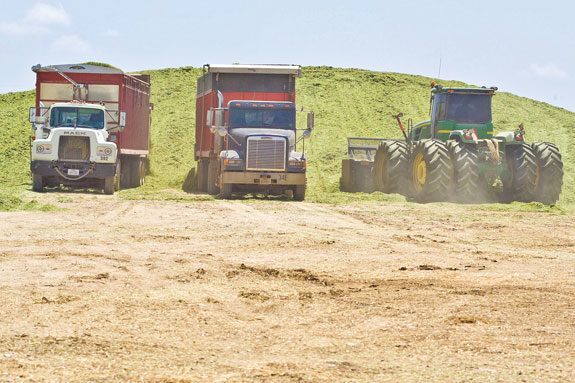Running some simple checks before and after harvest will help prevent problems and save you time in the long run. Here is a 12-point inspection you can perform on your silage truck bed.
1. Oil levels – Check all oil levels: engine, transmission and rear axles. Make sure the oil is filled to the proper level with the proper oil. Also make sure the transmission and PTO adapter are not leaking oil. A starved transmission will cost you a lot of money.
2. PTO control – While in the cab, engage and disengage the PTO. Does it go in easily or does it catch? Does the PTO vibrate? These may be early warning signs of problems you will not want to ignore or put off until next harvest. Also, while it’s engaged, get out and see how it moves and sounds.
3. PTO-driven hydraulic pump and reservoir – Also known as the “wet kit”. Check the u-joints and associated wet kit parts to make sure they are lubricated and not loose. Some tractors will also have a slip joint that should also be lubricated as well.
Checkpoints 4-12 refer to the forage bed not the truck itself.
4. Lines – Check your lines for worn spots or cracking. Check the connections for slippage or leaks.
5. Hydraulic motor – Check for leaks. Check the filter to make sure it has been changed at appropriate intervals.
6. Brackets for hydraulic motor – Sometimes the brackets become loose, so check to make sure they are tight.
7. Gear box – Occasionally it is good to let out a little oil from the gear box into a clean white bucket. Inspect the oil and and make sure large chunks of metal don’t empty out with oil. If this does happen, that could mean your gears are chipping.
8. Chains – Make sure the chains are not too loose or getting worn out. This includes the chains from the gear box and along the bed where the product will sit. Also look under the chains to make sure the surface where the chains rub on are not wearing out.
9. Bearings – With a pry bar carefully push on the bearings and make sure they are not too loose or too tight. When greasing the bearings look for gaps or too much play. Bearings have a life of their own. They only last so long before they wear out. Be sure to lubricate the truck chassis and connecting parts as outlined in the maintenance manual.
10. Pump and cap – Make sure the pump is working properly, free of leaks and that the cap is in place and secure.
11. Bed – Check the slats that move the product. Always ask yourself the following questions when inspecting the slats: Are they worn down? Is there a chance they could break on you? Is the bead wearing down? Are there holes in the bed? Is it clean and ready to be stored until next season?
12. Overall operation – Let the truck run without any product in the bed and make sure it runs smoothly. Get on the ground and look underneath the truck as it runs. Look in the back and watch the chains, slats and gears as they move. FG

- Jim Schlund
- Retired Diesel
Mechanics Professor - College of Southern Idaho










